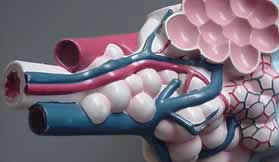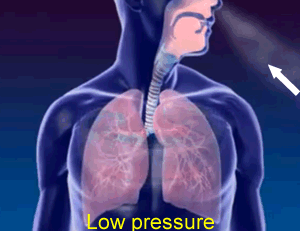
Hide internal view.

Hide internal view.
|
The diaphragm and the lungs |
||
|
The lungs are made from elastic spongy tissue. A strong muscle, separating the chest cavity and the abdomen, called the diaphragm, contracts and relaxes altering the internal pressure of the chest cavity. When the diaphragm contracts the chest cavity expands and its internal pressure falls. |
|
 |
The fall in the internal pressure of the chest cavity causes air to flow into the lungs. Click to see a video of a model lung, showing how the diaphragm regulates the internal pressure of the chest cavity. |
|
|
|
||
|
When the diaphragm relaxes
the lungs deflate on their own, much like a blown up balloon deflates
when the valve is released. The lung tissue is elastic and will return
the lungs back to their original size when the diaphragm relaxes. No effort
is needed to deflate the lungs, muscular effort is needed only when inflating. The picture on the left shows the spongy texture of the lung. Fine bronchioles are visible. Rings of cartilage keep these small tubes from collapsing. The tissue appears bright pink because it is rich in capillaries that bring blood to the lungs. |
|
|